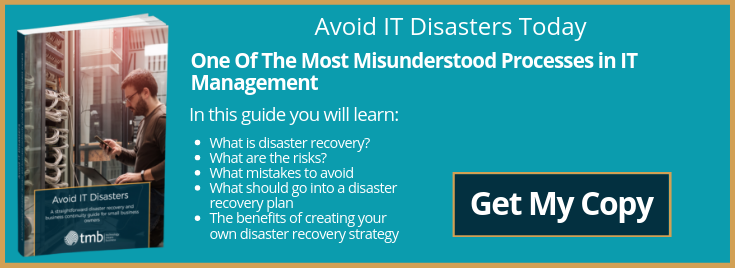Is There Room In Your Budget For Disaster?
There are no two ways about it: disasters cost money. The moment IT infrastructure is turned off, business stutters to a halt. It might be due to a malicious attack, or it could be something as simple as a power cut. Money does not discriminate. Knowing how to prepare for what UK government statistics show are inevitable eventualities makes all the difference, but how should you invest? After more than 30 years of providing 24/7 support, TMB has some experienced insight, so read on.
IT Blackouts: How Much Do They Really Cost?
This figure depends upon the size of your organisation, the type of blackout (data loss, hardware failure, malware, ransomware, denial of service, etc.), and how quickly you can be up and running again. You will see lots of different numbers, but it really depends on the individual circumstances. All that can be said with certainty is that the cost is likely to be considerable.
Part of disaster preparedness is working out what the cost means to you. This is reasonably easy to do. Calculate your average daily turnover and work out how much you would lose in the average length of an attack. This is your starting figure. Next, calculate your annual net profit, taking 30% off the normal figure. This 30% represents the average number of customers lost. Look at the two together, and you will have a reasonable idea of the worst-case scenario.
What Is The Cost Of A Disaster Recovery Plan?
This depends on whether you want to opt for an in-house or an outsourced option. In-house is usually much more expensive. This is not so much to do with the financial output required for software – although this can be hefty for reliable kit! – but is rather due to the requirement for fully trained data security specialists. Cyber-security is a constantly evolving discipline and keeping one step ahead of threats is a full-time job that requires a team of people with different niche skills. Those skills demand constant updating through training and development.
Outsourcing tends to be much more cost-effective, because it works in the same way as Software as a Service (SaaS) agreements. The specialist security team works quietly in the background, keeping your IT safe and secure, and only swings into guns-blazing action if a major problem arises. This has two financial benefits: firstly, the likelihood of a disaster is reduced; secondly, the training and expertise costs are shared. It’s a bit like the fire brigade – we all pay for them with council tax, rather than training and keeping our own in-house team.
What Are The Main Benefits Of Outsourcing?
Other than the expertise, the main financial benefit is the speed of recovery. Most experienced disaster recovery providers will have you back up and running within a matter of minutes. If you go back to the earlier calculation of how much you are likely to lose in combined downtime and loss of customers (anything from hundreds of thousands to millions,) that can make a significant difference.
What Should I Do?
This is a fast-evolving area, so the best advice is to read up on the topic. Either way, you will need a plan in place. A good place to start is by downloading our free Disaster Recovery Guide, which gives a detailed explanation of what is involved.


